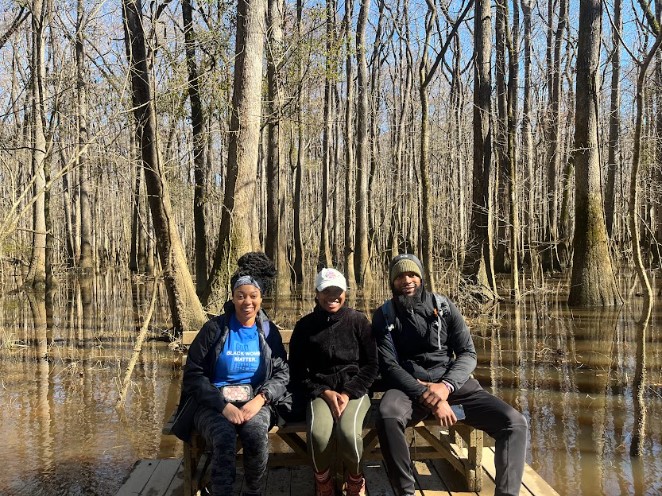Congaree National Park was the third stop on our trip, and I made the journey with my friends Tavon and Danielle. This trip really highlighted how picking the season that you visit a national park is important, because flooding in the area limited the trail options that we had to explore. But the weather didn’t stop us, and there was still plenty for us to discover and enjoy.
Traffic was heavy on our way there, so we arrived around 8 p.m., after it had already gone dark. Quick tip: download your campsite map before you arrive because there was low cell service in the area, which made it hard for us to find our campsite. Arriving as late as we did, we were thankful we chose Longleaf Campground – a short walk from parking to the tent sites – instead of Bluff Campground which would have required a longer hike to get there.
We initially planned to hike either the River Trail or Kingsnake Trail, but after talking to the wonderfully friendly park ranger Tom Sliney, we realized that those trails were completely impassible. Congaree National Park is the largest remaining tract of old-growth bottomland hardwood forest in North America and is in the flood plain of the Congaree River. As such, many of the trails are flooded during rainy seasons. Instead, Tom recommended the Boardwalk Loop, which turned out to be a very pleasant 2.6-mile trail, with an accompanying trail guide that provided a wealth of information about the wildlife and plants in the park.
We also went on a kayak tour, where I felt like I was personally connecting with my ancestors, as most of my family migrated from this part of the country. At the meeting of the Congaree and the Wateree rivers once existed a Maroon settlement of formerly enslaved persons who escaped and started their own thriving communities in the forest. The rivers provided food and means for acquiring supplies, while the dense vegetation in the forest provided safety and protection from slavers. As many Black people in America have roots in this area, my friends also had family who hailed from these lands. After the tour we headed about 1 hour east of Congaree to Sumter, South Carolina, which was where Tavon’s family is from and also shares its name with the site of the official start to the Civil War about two hours south of Congaree at Fort Sumter.
The night back at camp ended with an exhilarating experience as we sat around the campfire when suddenly erupting all around us was the sound of coyotes howling in the distance! We did go into somewhat of a panic at the time before realizing that they were far enough away from us to not pose a threat. However, we kept our bear spray at hand just in case!
Beginner friendly: Yes
Where to stay:
- We stayed at Longleaf Campground for $10 a night.
- Another option is the Bluff Campground, but that requires a 1-mile hike to reach the campsites.
- Backcountry camping is available in Congaree but is sometimes restricted because of flooding.
What to do:
- Boardwalk Loop
- An accessible, flat 2.6-mile loop with plenty of benches along the trail for people to take breaks and enjoy the views.
- Gullah Geechee Cultural Heritage Corridor
- A couple of hours away is the Gullah Geechee Cultural Heritage Corridor. These coastal lands are a National Heritage Area highlighting the historic and cultural contributions of the Gullah Geechee people, descendants of West and Central Africans who were enslaved and brought to the Carolinas, Florida and Georgia. The Gullah Geechee people developed their own language, Gullah, and maintained many elements of their Indigenous history and culture.
- This area was also a hub of the logging industry, and many Black people worked long hard hours, succumbing to malaria and the devastating working conditions while harvesting bald cypress trees for the Santee River Cypress Lumber Company.
- Harry Hampton Visitor Center
- Get your passport stamped.
- You can watch a movie on the history of the park at the center. The very first story in that video was from three Black women sharing about their family’s history in the park, which was a pleasant surprise for us.
- Get recommendations from park staff.
- Kayaking or canoeing
- The Cedar Creek Canoe Trail offers about 15 miles of waterway visitors can traverse.
- If you don’t have equipment of your own, a number of places in the area offer rentals.
- Kingsnake Trail
- 12 miles
- It’s a recommended trail for birders.
- River Trail
- 11.1 miles
- This trail leads to the Congaree River, and vegetation around this trail is denser than around other trails.
Where to eat:
- We brought our food with us for this trip, but Columbia is about 30 minutes away, and Charleston is about 2 hours away, and both offer plenty of delicious Southern eats.
